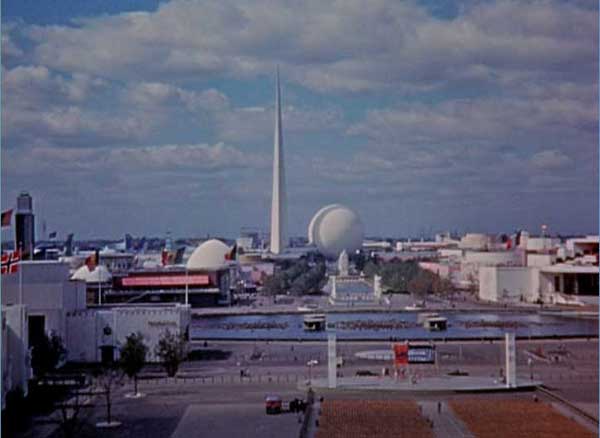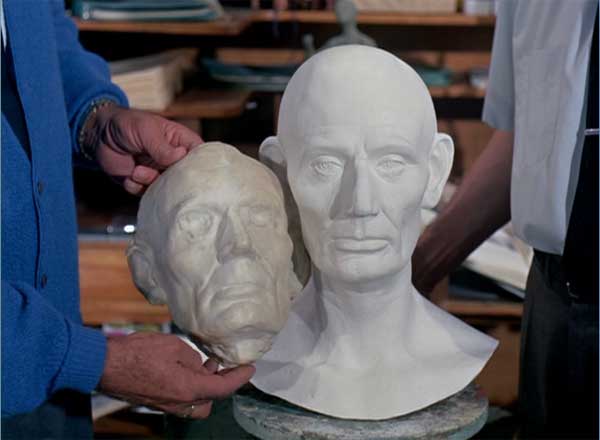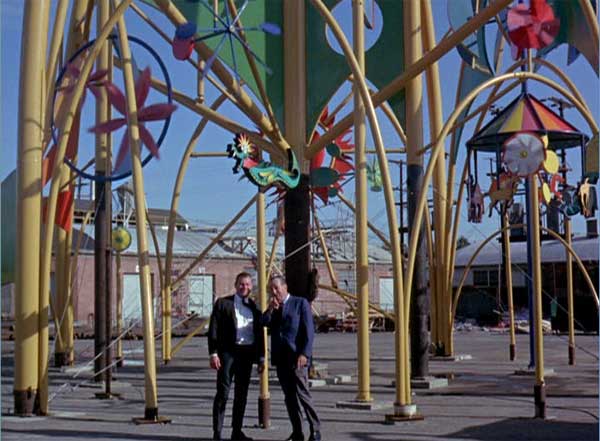
The 1960s were a remarkable time for the Disney company, particularly in theme park development. It’s amazing to look back at how many signature attractions were built in a short time. After introducing the Matterhorn, Monorail, and Submarine Voyage in 1959, Walt Disney kept pushing forward with new technologies. A centerpiece was the 1964-1965 World’s Fair in New York. All four Disney attractions would appear in some form at Disneyland following the event. Beyond the rides and shows, the technical achievements set the stage for modern theme parks around the world.
Walt was a master at promoting the parks, and one of the best examples was “Disneyland Goes to the World’s Fair”. First airing on May 17, 1964, the Walt Disney’s Wonderful World of Color episode sells the creative work of Walt’s team. It’s also a cool way to catch a glimpse at the development of the World’s Fair attractions. The scenes are goofy moments designed to sell the idea of WED as a whimsical place. Walt and his crew are kids playing with toys in this behind-the-scenes vision. It’s a fake yet valuable image of Disney’s process. This episode is a wonderful find that should be a must-see for diehard fans.
We begin with Walt having witty banter with three animatronic dinosaurs (“Huey, Dewey, and Louie”). It’s a cool way to introduce the many creations that we’ll see in the next hour. Walt seems giddy during the entire presentation, even more than usual. He doesn’t need to stretch to muster enthusiasm for WED’s work. Before we dive into the fun, there’s a surprisingly long animated piece on origins of the World’s Fairs. The highlight is the animation in front of drawings of 19th century events. The different styles used by Disney to tell the story are quite impressive.

Technological Achievements at the World’s Fair
Despite the silliness, there’s also an interesting look at technological advances in cameras and film making within these segments. The silent-film style works for the gags, and the color video presents the grandeur of the 1939 World’s Fair in New York. This progression leads well into the depiction of the 1964 event. Dubbed by Walt as the “greatest World’s Fair of all time”, it seems to represent the next step in our progress. The episode shines here because the spotlight now focuses on the Imagineers.
After a brief look back at past developments like the squid in 20,000 Leagues Under the Sea, Walt dives into the new attractions. We start with the Magic Skyway, which didn’t travel to Disneyland after the Fair. However, its dinosaurs moved to the Primeval World section of the Disneyland Railroad.
The Magic Skyway also was an early version of slow-moving Future World attractions like World of Motion and Spaceship Earth. The cavemen figures of the Skyway are more rudimentary yet seem familiar. Walt tries to sell them as humans during show scenes of daily life in humans’ early days.

Introducing Audio-Animatronics
The next segment frequently appears in documentaries chronicling Walt and Disneyland history. He presents a Tiki bird and introduces the term “Audio-Animatronics” to the audience. Blaine Gibson arrives to show his sculpted face of Abraham Lincoln, which is remarkably similar. We don’t see Lincoln in action, and it’s possible he wasn’t completed. Walt might also have been hiding the highlight to keep potential guests intrigued. This leads into my favorite part, a look at the original Carousel of Progress.
The shot of the Imagineer wearing the ridiculous contraption and controlling the Father is iconic. The control harness allows the operator to control his motions on tape, even blinks of his eyes. It reminds us how far we’ve come with technology in the past 50 years. The original elements still work, however. The core of the Carousel of Progress is present at the start.
Walt begins by showing us a small model of the circular show that’s surprisingly detailed. We even take a journey to see the large computers that run taped programs that make the show click. The animatronics look a little creepy up close, but it’s still a cool view of a classic Disney attraction.

A Wealth of Cool Footage
One of the highlight’s of Rolly Crump’s book It’s Kind of a Cute Story is learning about his work on the Tower of Four Winds. The 120-foot structure was a memorable landmark from the Fair near “it’s a small world”. It’s too bad that it wasn’t moved to Disneyland, though it’s hard to imagine such a large tower looming over the park.
Crump appears on this show to present a small model and visit the Tower. This leads us to the final segment at the actual Fair in New York. Our “ambassadors” are characters like Pluto, Pinocchio, and the Seven Dwarfs. They dominate the camera for a little too long, but it’s worth it once we board “it’s a small world”.
“Disneyland Goes to the World’s Fair” closes with essentially a full trip on “it’s a small world”. In the pre-Internet era, it was rare to see so much of an attraction before riding it. Walt knew what he was doing. Disney barely shows its rides in its own specials today! This episode is a treat today, but it also was a brilliant promotional tool for Disney in 1964. It’s a must see for any fan of the parks, particularly if you have interest in Disney history. I can’t wait to watch it again.
It’s easy to find “Disneyland Goes to the World’s Fair” online; here’s one good example. You can also pick up a copy of the Walt Disney Treasures DVD release Disneyland – Secrets, Stories, & Magic, which includes this and other gems.
Related Articles: Disneyland Goes to the World’s Fair
After the Fair: The Legacy of the 1964-1965 NY World’s Fair
Tomorrow-land: The 1964-65 World’s Fair and the Transformation of America
This post contains affiliate links. Making any purchase through those links supports this site. See full disclosure.



Nice piece on such a great episode.
Thanks David! I watched it a while back, but I’d forgotten how good the episode was. There’s so much to it.